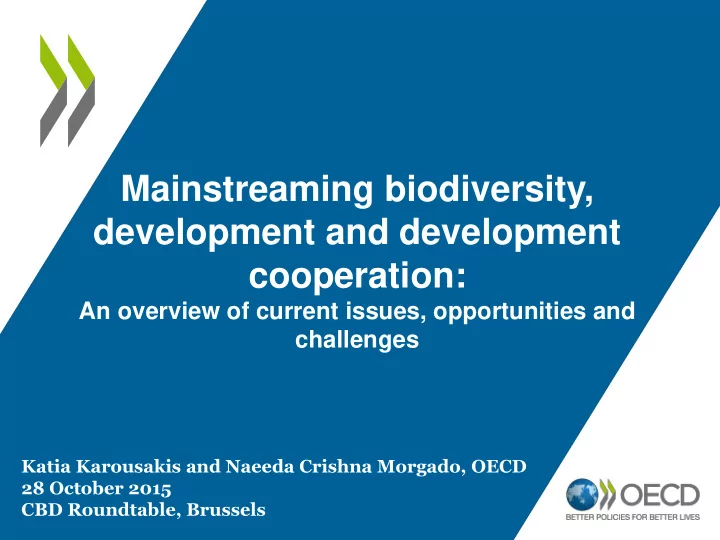

Mainstreaming biodiversity, development and development cooperation: An overview of current issues, opportunities and challenges Katia Karousakis and Naeeda Crishna Morgado, OECD 28 October 2015 CBD Roundtable, Brussels
Biodiversity and development Biodiversity and poverty reduction are intrinsically linked OECD objective: provide good practice insights into mainstreaming biodiversity and development including development co-operation 2
Entry points for mainstreaming biodiversity and development Build institutional capacity, provide policy advisory services DEVELOPMENT COOPERATION PROGRAMS Regional and country strategies, country operational plans, project plans; country missions, private sector partners, NGO partners Build technical capacity, support sector mainstreaming Build local capacity, test / demonstrate local level approaches 3 Adapted from OECD (2009). Integrating Climate Change Adaptation into Development Co-operation – Policy Guidance.
Biodiversity mainstreaming into development cooperation Biodiversity is being increasingly mainstreamed into ODA, and is • concentrated in a few sectors Biodiversity related ODA to capacity building-type activities has • increased Principal Significant Share of total ODA commitments to sector 42% 2.0 45% Share of total ODA commitments to Fishing Rural 5% 40% development sector argeting biodiversity 7% 35% 1.5 Agriculture 30% USD billion 45% Forestry 22% 25% 43% 1.0 20% 15% 11% 0.5 10% 3% 2% 5% 0.0 0% Agriculture, forestry, General Water Supply and Multisector Energy fishing and rural Environmental Sanitation development Protection 4 Source: DAC Creditor Reporting System , 2015
Tools and approaches for mainstreaming Several tools and approaches Economic valuation and exist, now important to focus on National scale up and improving Ecosystem Assessments effectiveness Public Ecosystem expenditure accounting review and (e.g. SEEA) performance indicators Mainstreaming: instruments, measurement and assessment tools Policy instruments Plan/project incl. economic assessment incentives and (e.g. reform of SEA,EIA, harmful GIZ IES) subsidies 5
Mainstreaming biodiversity and development: Challenges and opportunities • Focus needs to be on reciprocal mainstreaming Support development of strong scientific and economic • evidence base • Mainstreaming biodiversity requires sustained support for 10-15 years • Partnerships, building trust and stakeholder engagement is key to successfully supporting mainstreaming and to ensure ownership of mainstreaming process, including by local communities Reform of harmful subsidies to biodiversity and • complementary packages to address any possible regressive distributional impacts • Important to engage the private sector both directly and through support for enabling policies, incentives… • Performance assessment and adaptive management over time 6
Current OECD work on biodiversity, development and development co-operation • A joint OECD project between the Environment Directorate and Development Co-operation Directorate. Reaching out simultaneously to two communities for input, feedback and comments… • Kick-off workshop in February 2015 – http://www.oecd.org/env/resources/workshop-biodiversity- development-2015.htm including PPTs, co-chairs summary, etc. • Three themes to be addressed: Mainstreaming at national level Mainstreaming at sectoral level Monitoring and evaluation of mainstreaming 7
Mainstreaming at national level To examine inter alia : • Integration of development and poverty alleviation in NBSAPs Integration of biodiversity and ecosystem services in NDPs (and • other strategies) and top development co-operation providers Reciprocal mainstreaming For case study countries, examine: • – Policy frameworks and regulation to support mainstreaming Institutional and institutional capacity to support mainstreaming – – Extent of biodiversity reflected in national budgetary systems – Success and challenges encountered in mainstreaming 8
Mainstreaming at sectoral level Examples of sector level measures to reduce biodiversity loss and promote sustainable use Agriculture Forestry Fisheries Increase yields and efficiency Establish forest management plans Encourage adoption of reduced- bycatch fishing gear Reduce nutrient and pesticide Develop plantations in suitable Protect spawning sites losses areas Support local farmland Increase wood processing efficiency Set catch limits biodiversity Promote land and water Reduce illegal logging and trade Adopt mitigation measures at farm management level Promote biodiversity friendly Promote fuel efficient cook stoves Reform of harmful subsidies practice such as conservation and alternate energy sources for agriculture cooking Increase crop rotation and reduce Secure land tenure rights for local Individually Transferable Quotas monocultures people Utilise integrated pest Protect wildlife migration corridors Marine spatial planning management Taxes on e.g. pesticides and Eco-certification fertilisers 9 Reform of harmful subsidies
Monitoring for results • Monitoring challenges raised in context of biodiversity and development interventions include: lack of baselines, lack of methodologies including indicators, lack of capacity and funds. Possible indicators Type of indicator Input Process Output Outcome Integration into National Development Plan X X Integration into Poverty Reduction Strategies X X Integration into key sectoral plans (e.g., agriculture, forestry, X X mining, tourism, other) Status and implementation of National Ecosystem Assessment X Biodiversity and ecosystem services integrated into national accounting systems Inter-ministerial committee for biodiversity in place X X Assessment and removal of harmful subsidies (e.g. direct X (assessment) (reform / production support to agriculture, fisheries). removal) Use of environmental taxes to reflect biodiversity externalities X Use of other pricing mechanisms (charges/fees) to regulate use (and raise revenue for biodiversity) Amount of pesticide use X 10 Source: OECD on going work on biodiversity and development
Thank you! • Van Winkle et al (2015) “ Biodiversity Policy Response Indicators ”. OECD ENV WP 90 Drutschinin et al (2015) “ Biodiversity and Development Co-operation ” OECD DCD WP 21 • • Drutschinin and Ockenden (2015) “ Financing for Development in Support of Biodiversity and Ecosystem Services ” OECD DCD WP23 • Wilson et al (2014). “ The Role of National Ecosystem Assessment in Influencing Policy Making” . OECD ENV WP 60 OECD (2013) Scaling Up Finance Mechanisms for Biodiversity • – incl. chapter 8 on “ Biodiversity in International Development Finance” • OECD (2012) Environmental Outlook to 2050: The Consequences of Inaction . Chapter on Biodiversity. Visit: www.oecd.org/env/biodiversity and www.oecd.org/dac/environment-development Contact: Katia Karousakis, Environment Directorate (katia.karousakis@oecd.org) Naeeda Crishna Morgado, Development Co-operation Directorate (Naeeda.CrishnaMorgado@oecd.org) 11
Recommend
More recommend